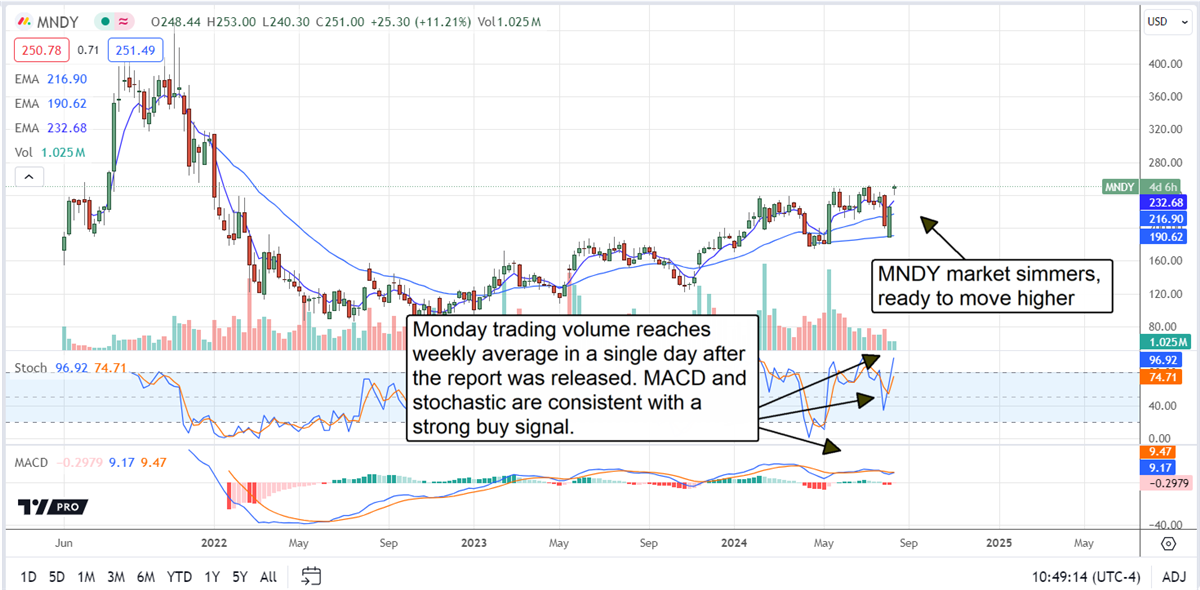Ticker Reports for August 12th
How to Invest in Silver: A Beginner's Guide
Read on to learn more about silver as an asset class, the multiple ways that you can invest in silver, and a few of the benefits and drawbacks of this ancient investment asset.
Ways to Invest in Silver
There are multiple investment assets that you can use to add silver exposure to your portfolio, including both physical silver investments and stock-based options like silver ETFs. You can also gain exposure to precious metals by investing in adjacent industries like mining and silver refinement to profit from potential price differences. Let's take a look at a few ways you can invest in silver.
Physical Silver
The most straightforward way to invest in silver is to purchase and hold physical silver, which is sold as an investment in two primary types:
- Bars: Investment-grade silver bars usually have a purity of at least 99.9%, which is marked as .999 fine silver. Fine silver bars are sold in a variety of sizes ranging from one ounce to 1,000 ounces, with the most common denominations being one, 10 and 100-ounce bars.
- Coins: Like bars, most silver coins are sold with a purity of 99.9% pure silver. Most silver coins are issued by financial government bodies like the U.S. Mint and the Royal Canadian Mint.
When investing in silver bars and coins, be sure that you’re purchasing through a reputable manufacturer like Johnson Matthey, Engelhard, or the Royal Mint. Some self-directed IRA providers even allow you to invest in silver with retirement benefits, with the custodian handling both purchase and storage. Most investors who hold their own physical investments choose to do so in a bank safety deposit vault or private vault company.
Silver Stocks
A more convenient way to invest in silver is to buy and hold stock of companies associated with the mining, refining, and sale of silver. When adding silver exposure to your portfolio, you can choose from multiple classifications of companies, including:
- Silver Producers: Primary silver producers provide the most direct way to profit from price changes in silver, as these companies are engaged in the direct mining and production of these products. An example of a major silver production stock is First Majestic Silver (NYSE: AG), a gold and silver mining company with operations in Canada and Mexico.
- Diversified Mining Stocks: General mining stocks do not focus specifically on precious metals but may combine silver mining activities with zinc, copper, or other types of ore extractions. BHP Group (NYSE: BHP) is a classic example of a highly diversified mining operation, with copper, uranium, molybdenum, gold, iron ore and coal mining segments in addition to silver investments.
- Streaming and Royalty Stock Companies: Streaming and royalty companies provide upfront financing to miners in exchange for a percentage of future production or revenue. For example, Franco-Nevada (NYSE: FNV) is a Canada-based company that provides financing for operations in South and Central America.
Investing in silver stocks is easier than investing in physical silver because you don’t need to worry about storage, finding a reputable provider or locating an IRA provider that offers silver investment options. It also solves the problem of liquidity, with most brokerage service providers allowing you to queue sales orders around the clock.
Silver stocks listed on major exchanges like the New York Stock Exchange must meet financial and oversight criteria before being listed, but they may still be especially volatile assets. Silver has traditionally displayed more drastic daily price changes than comparable precious metals like gold, which means that silver stocks may also see sudden changes in value.
Silver ETFs
An exchange-traded fund (ETF) is a type of fund that pools money together from multiple investors to invest in a particular type of stock or asset. Silver ETFs can be popular choices for beginners, allowing you to invest in a “basket” of stocks with a single purchase. These ETFs also provide a higher level of diversification, spreading your risk across multiple stocks. Like stock investments, the individual companies that make up the ETF may be engaged in both direct silver mining or a supplemental industry like refining or ore mining finance.
A quintessential example of a silver ETF is the iShares Silver Trust (NYSE: SLV). One of the largest and most popular silver ETFs, SLV holds physical silver bullion, providing investors with exposure to the direct price changes silver experiences. In August of 2024, it had more than $13 billion in assets under management as well as an accessible share price of less than $27.
Pros of Investing in Silver
Investing in silver as an asset class provides a unique level of diversification to your portfolio, including the following potential benefits.
Hedge Against Inflation
Precious metals like silver have traditionally been incorporated into portfolios as a hedge against inflation because they tend to retain value better during periods of inflation. When the value of currency falls, the price of silver may rise, preserving purchasing power.
Increased Demand During Growth Periods
The industrial uses of silver also contribute to increased demand during periods of high growth. For example, silver is an essential component of most solar panels because of its high thermal capacity. This means that during periods when there is an increased demand for solar panels, silver may see a corresponding increase in price. When you consider its uses across industries like medicine, mining and electronics, investors may see multiple opportunities to profit from changing prices as demand ebbs and flows.
More Affordable than Gold
As you compare precious metals to incorporate into your portfolio, you’ll find that silver is significantly more accessible than other popular choices like gold. In August of 2024, gold had an average spot price of $2,454 per ounce, while silver had an average price of $28.77 per ounce. If you’d like to add the benefits of physical metal commodities to your portfolio but cannot afford the high price of gold, silver can be a strong alternative.
Portfolio Diversification
Silver provides diversification benefits. As a physical asset, it can reduce the overall risk of a portfolio that may be heavily weighted in stocks and bonds.
Cons of Investing in Silver
While silver is a popular commodity investment, it does come with the risk of potentially sharp losses — especially when taking into account silver’s higher volatility rate.
Price Volatility
Silver is a more volatile asset than gold, meaning that it may see more drastic changes in its spot price throughout the day. If you’re closer to retirement and unable to handle a higher level of volatility, another investment could be a better choice.
Storage and Insurance Costs
Physical silver requires secure storage, which can incur additional costs. When investing in physical silver, you’ll need to do your research before choosing a manufacturer and decide the most practical way to store your investment.
If you choose to store silver at home, you'll need a secure location, such as a safe, and you may want to purchase insurance to protect against theft or damage. Alternatively, storing silver in a bank safety deposit box or a professional vault incurs ongoing rental or storage fees, which can add up over time.
If you invest in Silver ETFs, Mutual Funds, Closed-End Funds, or IRAS, the custodian is responsible for securely storing the silver in professional vaults, often insured.
Lower Liquidity Compared to Gold
Silver markets can be less liquid than gold, especially in large volumes, potentially making it harder to sell at favorable prices.
Economic Sensitivity
Since silver is heavily used in industrial applications, its price can be more sensitive to economic downturns. A recession or slowdown in industrial demand can negatively impact prices.
Investing in Silver for Beginners
Investing in silver can provide many of the same inflation safeguard benefits of gold at a lower price point. However, new investors may want to consider adding silver stocks or ETFs to their portfolio rather than physical silver. These assets are easier to buy and sell while also allowing you to benefit from the potential positive price movement silver will see in the future while making up only a portion of your overall investments.
Start Your Research with MarketBeat
Investments like physical silver may show different price movement trends than the overall market. Staying up-to-date with the latest market movements can enhance your trading without spending hours scouring the web for breaking stock news. Click here to sign up for a trial of MarketBeat’s premium market research reports and get stock market info delivered straight to your inbox daily.
Is Apple Plotting to Kill Its iPhone?
Rumors are swirling about Apple's secret AI lab. Now, insiders hint that an AI-powered device could render today's iPhone obsolete. Codenamed MM1, this project has the potential to disrupt the smartphone industry. With Apple scooping up $1.6 TRILLION in iPhone sales since its launch… Will YOU be in position for what Apple's "next big thing"?
Click here now to see all the details.Monday.com's Stock Results Will Brighten Any Investor's Week
Monday.com (NASDAQ: MNDY) had another beat-and-raise quarter because the combination of its offering and operational quality delivered results. The company delivers results for its clients and investors and has its stock on track to hit a multi-year high soon. The question is whether this market will dip again before crossing the critical threshold and if there is a chance it might. The takeaway is that, dip or no dip, this market is simmering and could come to a boil at any time.
Monday.com Advances After Another Beat-and-Raise Report
Monday.com technology resonates with users because of its plug-and-play platform. The platform is easy to use, systems are easy to assemble, and results are quick to follow. The business's revenue grew by 34.4% in Q2 to $236.1 million, accelerating its growth sequentially from Q1 and sustaining a high double-digit pace for another year. The revenue is also 300 basis points above the analysts' consensus figure, compounded by increased guidance, so investors may expect to see them revise their estimates and price targets higher.
The dual forces of increased client counts and service penetration drive revenue growth. Client growth approached 50% for businesses contributing more than $50K and $100K in annual recurring revenue, with net retention up 110% systemwide and 114% for large clients. Net retention is a measure of revenue generated by existing clients. A figure above 100% shows increased penetration: Monday.com’s figures show business momentum is present and driven by more lucrative, larger businesses.
As good as the top-line data is, the margin and bottom-line news is better. The company’s increasing revenue leverage and push toward more efficient operations significantly improved all margin comparisons and the first quarter of GAAP profits. The adjusted operating margin widened by 700 basis points to 16%, driving a 130% increase in adjusted operating income and robust cash flows. Cash flow is up 17% compared to last year, with the only bad news being a contraction in the FCF margin. However, FCF is up 10% compared to last year on a solid 21% FCF margin, providing nearly $51 million in useable cash.
Guidance is the brightest spot of this report. The company raised guidance for Q3 and the year, putting the new targets' low ends above the consensus estimates. The guidance may also be cautious, given the trends, which include numerous guidance increases followed by company outperformance. Regarding the balance sheet and the company’s financial health, Monday.com is net-cash with cash rising and total liability leverage less than 0.5x the cash position. Liability also rose but was insufficient to offset cash and asset builds, leaving shareholder equity up 12% YOY.
Analysts Are Lifting Sentiment and Price Targets for Monday.com
No analysts issued a revision in the first few hours following Monday.com’s Q2 release, but they will likely be positive when they come. Until then, the sentiment trend is bullish, leading the market to a fresh multi-year high. Critical details include a 25% increase in analysts covering the stock over the past twelve months and a rising price target. The involvement of 16 analysts indicates a strong belief that this stock will surpass the $255 consensus price target, potentially reaching closer to $300. The $255 target is a critical detail because it would be the highest traded price for this stock since early January 2022.
The market for MNDY is struggling with resistance at the current high, but the action is suggestive that a higher move is coming. The trading volume is rising, and the MACD and stochastic indicators are forming a solid buy signal that will likely extend the rally. The technical targets suggest a move above $300 is possible before the year’s end.

CNBC's 'Prophet' issues urgent Fed warning
"How I 6X-ed my wife's 401K in 1 year"
At the peak of the dot-com boom, a former hedge fund manager put all $20,000 of his wife's 401k into shares of just ONE stock. Everyone on Wall Street said he was crazy. But a year later, that $20,000 in his wife's account was worth $120,000. Today, he says: "If you thought the dot-com mania was intense, what's about to happen in the coming weeks could be even crazier and could open up a new window of opportunity for 500%-plus gains."
3 Must-Watch Stocks After a Bullish Goldman Sachs Recommendation
Investors are shaken up after last week's volatility in the stock market, which rocked indexes from Tokyo to New York. This left all participants with the concern that more could be coming in the following weeks. Knowing that there is a confidence gap to be filled for those who rely on professional advice and information, some banks have stepped forward to help out.
Today, Goldman Sachs Group Inc. (NYSE: GS) analysts shed some light on the potential selection criteria that could help investors navigate today's and tomorrow's marketplace. Analyst Peter Oppenheimer wrote that the bank is still in defensive mode as markets face election and geopolitical volatility, so the call is for quality growth companies with stable cash flows. It looks like value stocks with a strong dividend and buyback program could fit the description.
There weren't any specific stocks in this recommendation list. Still, the descriptions were enough for some investors to justify adding Realty Income Co. (NYSE: O) through steady real estate investment trust (REIT) dividends and predictable cash flows. Additionally, PepsiCo Inc. (NASDAQ: PEP) operates in the consumer staples sector and also fits the profile. Last but not least, investors could consider the insurer American International Group Inc. (NYSE: AIG).
Realty Income Stock's Stability Delivers the Complete Goldman Package
Investing in REITs offers investors several benefits, the main one being dividend payouts. In the case of Realty Income, there is a $3.15 share payout per year, which translates to a 5.2% dividend yield that beats not only inflation but also the ‘risk-free’ yield offered by U.S. 10-year bonds.
Not to mention, this dividend is paid out on a monthly—not a quarterly—basis. According to the company’s investor presentation, dividend payouts have been running for up to 29 consecutive years, growing at 4.3% per year on average. It’s like getting a raise without doing any extra work.
So, with a focus on predictable cash flows, real estate doesn’t get much better than that. Realty Income’s tenants include businesses like CVS Health Co. (NYSE: CVS) and Walmart Inc. (NYSE: WMT), creating confidence for the company that rent will be paid and probably on time.
This is why analysts at Tigress Financial have placed an $86 price target on Realty Income stock, daring it to rally by as much as 25.5% from where it trades today. That sets the pace for Goldman’s filtering process, income with upside so far.
PepsiCo Stock: Steady Demand Drives Both Income and Upside Potential
People think PepsiCo is essentially about soda products, but that’s not even half the story. This company has a snack segment that offers anything from chips to popcorn. They are also exposed to water products. The trend is definitely focused on consumer staples products that have strong and predictable demand.
Fitting the profile, Wall Street analysts forecast up to 7.5% earnings per share (EPS) growth in PepsiCo stock for the next 12 months, above its main competitor, Coca-Cola Co. (NYSE: KO) 's forecast of only 5.9% for the year. Noticing the greater growth potential and stability in PepsiCo, price targets were also raised along with this view.
Those at Barclays decided that PepsiCo stock is worth closer to $187 a share, which directly calls for up to 8.4% upside from where it trades today. More than that, the company offers a $5.42 payout per share, which translates into an annual dividend yield of 3.14%.
While this income is lower than Realty Income's, investors make the trade-off through upside. Even bearish traders have realized the upside that could be coming to PepsiCo stock, which is why the company’s short interest has declined by 10.6% in the past month, a sign of bearish capitulation.
American International Group Stock: Unlocking Ultimate Upside in Its Resilient Business Model
The nice thing about an insurance company is that it is the closest thing to being a real estate landlord. The income typically comes not through rent but through monthly premiums. Having a team of mathematicians calculate payout risk also allows the company to reinvest and create a return on the capital held within the company.
Warren Buffett realized the potential compounding effects of this business model, which is why he sought to invest in insurance companies for their 'float' in his early days. That is also why American International Group stock carries the highest upside in this list.
Analysts at J.P. Morgan Chase & Co. believe this insurer is worth $93 a share, which offers a net upside of 29.1% compared to today's prices. To top off the characteristics of this stock within Goldman's recommendation, Wall Street predicts up to 15.2% EPS growth for the next 12 months.
Speaking of further upside in the stock, management reiterated that prices could be higher. After an upbeat second quarter 2024 earnings result, management approved a $10 billion buyback program, up to 21.5% of the company's market capitalization.





